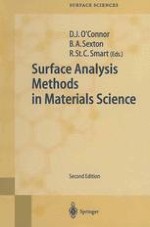2003 | OriginalPaper | Buchkapitel
Low Energy Ion Scattering
verfasst von : D. J. O’Connor
Erschienen in: Surface Analysis Methods in Materials Science
Verlag: Springer Berlin Heidelberg
Enthalten in: Professional Book Archive
Aktivieren Sie unsere intelligente Suche, um passende Fachinhalte oder Patente zu finden.
Wählen Sie Textabschnitte aus um mit Künstlicher Intelligenz passenden Patente zu finden. powered by
Markieren Sie Textabschnitte, um KI-gestützt weitere passende Inhalte zu finden. powered by
Low energy ion scattering (LEIS) is the study of the structure and composition of a surface by the detection of low energy (100 eV-10 keV) ions (and atoms) elastically scattered off the surface. This technique is a subset of ion scattering spectrometry which involves the use of incident ions with energies ranging from 100 eV to over 1 MeV. The range of measurements possible over such a large range of energies extends from purely atomic layer resolution at the low energy end to analysis to depths of the order of microns at the high energy end. Some of the high energy effects (> 250 keV) are covered in Chap. 9, while the intermediate energy range (medium energy ion scattering) has been successfully developed as a near surface structure probe mentioned briefly in Chap. 1. The use of low energy ions to measure the surface structure of solids was established by Smith [1] in 1968. In that study the basic elements of LEIS were established and these have been built on over the past 20 years to develop into a powerful surface atomic layer structure and composition probe [2–6]. It has been successfully applied to a wide range of practical surface problems which include the surface composition analysis of:binary alloyscatalystscathode surfacespolymerssurface segregationadsorbatessurface structureadsorbate site identification
